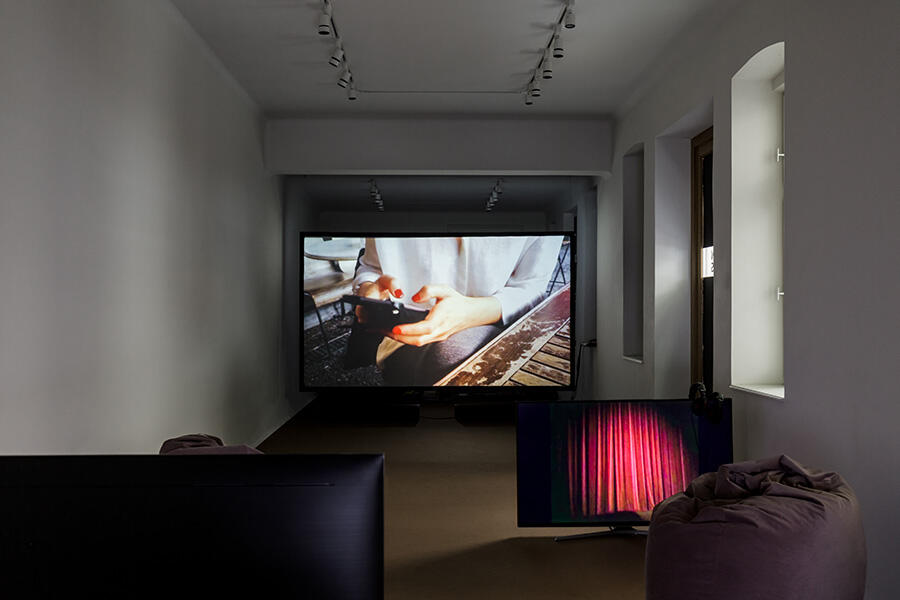Ruth Novaczek Twists the Trope of the ‘Broken’ Women
On view at Kunstverein Gartenhaus, Vienna, the artist’s emotive, fragmentary films shift the locus of desire with feminist determination
On view at Kunstverein Gartenhaus, Vienna, the artist’s emotive, fragmentary films shift the locus of desire with feminist determination

The female lament in Ancient Greece was so disruptive, according to Anne Carson in her fascinating essay ‘The Gender of Sound’ (1992), that women were discouraged from ‘pour[ing] forth unregular cries […] within the earshot of men’. Ruth Novaczek’s emotive, fragmentary films – currently the subject of a retrospective at Kunstverein Gartenhaus, Vienna – are equally unruly, giving a platform to myriad female and non-binary friends to noisily expound their thoughts on love and life. In doing so, the London-based artist and poet raises a plethora of questions: what does the female gaze look like? When is an artwork a self-portrait? And when is a film a text?

Although the five films on display are autonomous, they run concurrently in the Kunstverein’s lone narrow space, suggesting they form a single, multipart series. All the works have a similar low-fi aesthetic and format: an amalgam of fragments including Super 8 and camera-phone imagery, found documentary footage, interviews with friends and authors, fictional performed moments and numerous clips from old movies, with film noir and European mid-20th-century cinema as ongoing references. Novaczek’s women run between spaces, endlessly smoking and drinking coffee, battling with internal demons and emotional upset. They function as facets of the artist herself, who reads a poetic monologue over each piece.
In her companion essay for the show, ‘Deliberately Lost’ (2021), Eileen Myles notes that Novaczek ‘loves melodrama, she’s steeped in it but she’s disobedient to its unerring narrative’ and she’s certainly not adverse to filling her films with vulnerability and emotion. In Footnote (2016), for instance, Myles, Chris Kraus and Salit Krac discuss conceptions of love. Novaczek, like these writers, shifts the locus of desire with feminist determination. She takes the trope of the preoccupied woman and repositions it as something vital and engaged. This is illustrated by her own footage as well as found filmic moments of women in emotional extremes, such as Jeanne Moreau walking the street of Paris at night, searching for the lover she suspects has abandoned her, in Louis Malle’s Lift to the Scaffold (1958), which appears in Crime Scene (2017), sandwiched between scenes of Tel Aviv streets at night and stormy waves hitting beaches. Rather than damsels in distress, Novaczek’s characters – who are often described in her voice-overs as detectives or observers – are shown planning their next move as they stare out of airplane windows or smoke cigarettes.

The artist’s poetry is essential to the structure of each film, with many of her works embedded in the New York-centric queer autofiction of writers such as Kraus or Kathy Acker. There seems to be an ongoing desire to communicate, which is endlessly thwarted or unfulfilled. Phones are an ongoing motif. A handset hangs in a graffiti-covered metal phone box in New York in Eat the Dust (2019). The romantically oriented Footnote includes what appears to be autobiographical footage of the artist refusing a call from an ex-lover. Novaczek seems to be highlighting the failure of emotional communication, the struggle for words and image to convey meaning. Fiction and fact blur, and we are left with a poetic lack of clarity.

The films feel as though they were made in transit, reflecting a psycho-geographic life that stumbles between Berlin, London, New York and Tel Aviv. There is a textural shift in all this: out-of-focus, hand-held aesthetics interspersed with moments of Hollywood high precision. The stock regularly switches between colour and black and white. There is a sense of reality, yet the films are clearly unreal. False stories and imaginary lives merge with memories and autobiography. Novaczek’s work resists and reclaims the representation of women – something that would make Carson’s rowdy forebears proud.
'Ruth Novaczek: Retrospective' is on view at Kunstverein Gartenhaus, Vienna, until 30 October.
Main image: Ruth Novaczeck, Eat the Dust, 2019, film still. Courtesy: the artist and Kunstverein Gartenhaus, Vienna
Thumbnail image: Ruth Novaczeck, Footnote, 2016, film still. Courtesy: the artist and Kunstverein Gartenhaus, Vienna























